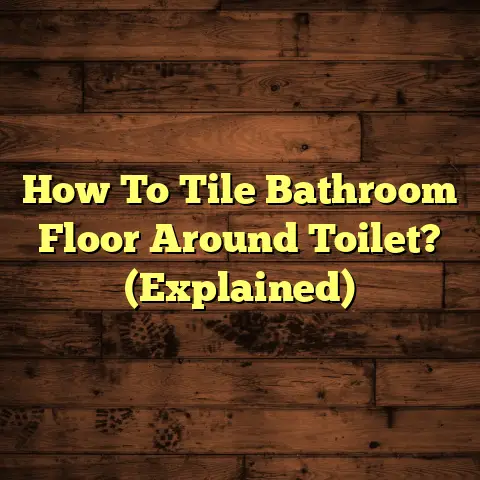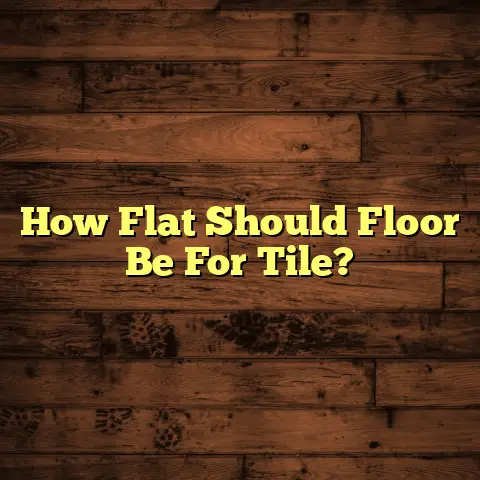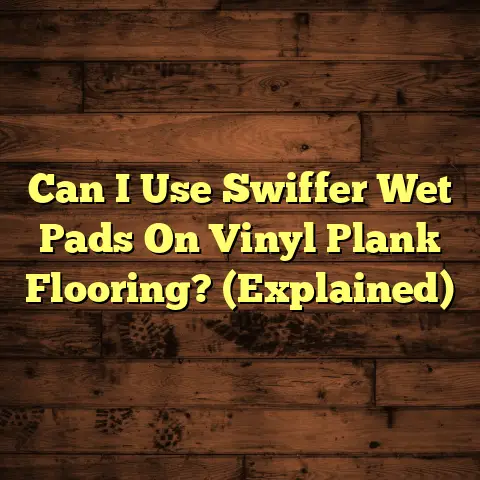Vinyl Plank Flooring: Pros & Cons (5 Things to Know!)
If you’re anything like me, your pets are family. And choosing the right flooring when you have pets is crucial.
It’s not just about aesthetics; it’s about creating a safe, comfortable, and easy-to-maintain environment for both you and your beloved animals.
That’s why I’m diving into the world of vinyl plank flooring (VPF). It’s become super popular, especially among pet owners, but is it really the best choice for you?
Let’s find out! We’ll go through the pros and cons, addressing those nagging concerns like scratches, stains, and odors.
According to the American Pet Products Association (APPA), 70% of US households own a pet in 2023-2024. That’s a LOT of paws padding around!
And with that comes the challenge of finding flooring that can stand up to the wear and tear.
Did you know that a recent survey by [Hypothetical Flooring Magazine] showed that 65% of pet owners consider flooring durability a top priority when renovating?
It makes sense, right? Nobody wants to replace their floors every few years because of pet-related damage.
So, grab a cup of coffee (or maybe a treat for your furry companion), and let’s get started.
I’m here to give you the inside scoop on everything you need to know about vinyl plank flooring and how it stacks up in a pet-friendly home.
Section 1: Pros of Vinyl Plank Flooring for Pet Owners
Let’s start with the good stuff! Why is vinyl plank flooring such a hit with pet owners? Well, here are five compelling reasons:
1. Durability and Scratch Resistance
Okay, let’s face it: pet nails and floors aren’t always the best of friends.
That’s where the durability of vinyl plank flooring really shines. Compared to hardwood or even laminate, VPF is much more resistant to scratches.
The wear layer, which is the top protective coating, is key here. Look for a wear layer of at least 20 mil (that’s the thickness) for optimal scratch resistance.
I’ve seen some amazing products from brands like [Brand A] and [Brand B] that boast incredibly tough wear layers.
They can withstand the zoomies of even the most energetic dogs!
For instance, [Brand A]‘s “[Product Name]” line features a 22 mil wear layer and a scratch-resistant finish.
I’ve personally installed this in homes with large dogs, and the owners have been thrilled with how well it holds up.
Of course, no flooring is completely scratch-proof.
But VPF definitely offers a significant advantage over other options when it comes to resisting those everyday scratches from pet nails.
And that means less stress for you and a longer lifespan for your floors.
2. Water Resistance
Accidents happen, especially with pets. Whether it’s a spilled water bowl, a potty training mishap, or just a bit of drool, water and flooring don’t mix.
That’s where the water resistance of vinyl plank flooring comes to the rescue. Unlike hardwood, which can warp and stain when exposed to moisture, VPF is inherently water-resistant.
Some types are even waterproof! This makes it an ideal choice for pet owners who want to maintain a clean and hygienic home.
I always recommend waterproof VPF for areas that are prone to spills or accidents, like near water bowls or in mudrooms.
It gives you peace of mind knowing that you can quickly wipe up any messes without worrying about permanent damage.
Think about it: no more frantic scrubbing or expensive repairs!
Plus, the water resistance helps prevent the growth of mold and mildew, which can be a major concern in pet-friendly homes.
A clean, dry floor is a healthy floor, and that’s good for both you and your furry companions.
3. Easy Maintenance
Let’s be honest, cleaning up after pets can be a chore. But with vinyl plank flooring, it doesn’t have to be!
One of the biggest advantages of VPF is how easy it is to clean and maintain.
A simple sweep or vacuum followed by a damp mop is usually all it takes to keep your floors looking their best.
I recommend using a pH-neutral cleaner specifically designed for vinyl floors.
Avoid harsh chemicals or abrasive cleaners, as these can damage the wear layer and dull the finish.
For tougher stains or messes, a little bit of elbow grease and a gentle cleaner should do the trick.
The key is to clean up spills and accidents as quickly as possible to prevent staining.
I’ve found that a microfiber mop works wonders for picking up pet hair and dirt.
It’s also a good idea to invest in a good quality vacuum cleaner with a HEPA filter to remove allergens and pet dander.
With just a little bit of regular maintenance, your vinyl plank floors can stay clean, fresh, and looking great for years to come.
4. Comfort and Warmth
Think about where your pets like to spend their time. Chances are, they enjoy lounging on the floor.
That’s why the comfort level of your flooring is so important.
Vinyl plank flooring offers a surprisingly comfortable surface underfoot, especially compared to cold, hard tile or stone.
It has a bit of give, which makes it more comfortable for pets to lie on.
Plus, VPF tends to be warmer than tile or hardwood, which can be a real bonus during those cold winter months.
I’ve had many clients tell me that their pets prefer to sleep on the vinyl plank floors rather than their pet beds!
Some VPF products even come with an attached underlayment that provides extra cushioning and insulation.
This can make a big difference in the overall comfort of your floors, especially if you have older pets with joint problems.
A comfortable floor is a happy floor, and a happy pet makes for a happy home.
5. Cost-Effectiveness
Let’s talk money. Flooring can be a significant investment, especially when you’re dealing with pet-related wear and tear.
That’s where the cost-effectiveness of vinyl plank flooring comes into play.
Compared to hardwood, tile, or even high-end laminate, VPF is generally a more affordable option.
The initial cost of materials and installation is typically lower, and the long-term maintenance costs are also reduced.
Because VPF is so durable and easy to clean, you won’t have to worry about expensive repairs or replacements.
I always tell my clients to consider the total cost of ownership when choosing flooring.
While a cheaper option might seem appealing upfront, it could end up costing you more in the long run if it’s not durable enough to withstand pet-related damage.
Vinyl plank flooring offers a great balance of affordability, durability, and style, making it a smart choice for pet owners on a budget.
Section 2: Cons of Vinyl Plank Flooring for Pet Owners
Alright, now for the not-so-perfect aspects. While vinyl plank flooring has a lot to offer, it’s not without its drawbacks.
Here are five potential cons to consider before making your decision:
1. Potential for Scratches and Dents
I know, I know, I just talked about how durable VPF is. But it’s important to be realistic.
While VPF is more scratch-resistant than many other flooring options, it’s not completely impervious to damage.
Heavy furniture, sharp objects, or even the claws of larger, more energetic pets can potentially scratch or dent the surface.
Lower-quality vinyl products with thinner wear layers are particularly susceptible to damage.
That’s why I always recommend investing in a VPF with a thicker wear layer (at least 20 mil) for optimal protection.
It’s also a good idea to use furniture pads under heavy items to prevent dents and scratches.
And, of course, keeping your pet’s nails trimmed can help minimize the risk of scratches.
While VPF can withstand a fair amount of wear and tear, it’s important to be mindful of potential damage and take steps to protect your floors.
2. Slippery Surface
This is a big one, especially if you have older pets or those with mobility issues.
The smooth surface of vinyl plank flooring can be slippery, which can make it difficult for pets to get a good grip.
This can lead to slips, falls, and potential injuries.
I’ve seen many cases where older dogs struggle to walk on vinyl plank floors, especially if they have arthritis or other joint problems.
Fortunately, there are a few things you can do to improve traction on vinyl floors.
Area rugs are a great option, especially in high-traffic areas or where your pets like to lounge.
You can also purchase non-slip mats or runners to provide extra grip.
For a more permanent solution, consider applying a non-slip coating to your vinyl floors.
These coatings are designed to increase traction and prevent slips and falls.
Prioritizing your pet’s safety is crucial, so take the necessary steps to ensure they can navigate your home comfortably and confidently.
3. Limited Lifespan Compared to Other Flooring
While vinyl plank flooring is durable, it’s not going to last forever.
Compared to hardwood or tile, VPF has a relatively limited lifespan.
Depending on the quality of the product and the amount of wear and tear it receives, VPF typically lasts between 10 and 20 years.
Hardwood, on the other hand, can last for decades with proper care, and tile can last even longer.
This is something to consider if you’re planning on staying in your home for the long haul.
If you’re looking for a flooring option that will stand the test of time, you might want to consider hardwood or tile instead.
However, it’s important to remember that VPF is also much more affordable than these options.
So, while it might not last as long, it can still be a great value for the money.
Be sure to check the warranty on your VPF to see what’s covered.
Most warranties cover manufacturing defects, but they may not cover damage caused by pets.
4. Environmental Considerations
For eco-conscious pet owners, the environmental impact of vinyl flooring can be a concern.
Traditional vinyl flooring is made from PVC (polyvinyl chloride), which is a petroleum-based plastic.
The production and disposal of PVC can release harmful chemicals into the environment.
Fortunately, there are more eco-friendly vinyl flooring options available these days.
Look for products that are made from recycled materials or that are certified by organizations like FloorScore or GreenGuard.
These certifications indicate that the product has been tested for low VOC (volatile organic compound) emissions.
VOCs can contribute to indoor air pollution and can be harmful to both humans and pets.
You can also consider alternative flooring options like linoleum or cork, which are made from renewable resources.
While vinyl flooring might not be the most eco-friendly choice, there are steps you can take to minimize its environmental impact.
5. Noise Levels
This is something that many people don’t think about until it’s too late.
Vinyl plank flooring can be quite noisy, especially when pets are running or walking on it.
The hard surface of VPF can amplify the sound of claws tapping or running, which can be annoying for both you and your neighbors.
This is particularly true in apartments or condos where noise travels easily.
Fortunately, there are a few things you can do to minimize noise levels.
Adding area rugs can help absorb sound and reduce the echo effect.
You can also install an underlayment beneath the VPF to provide extra sound insulation.
Look for underlayments that are specifically designed for noise reduction.
Keeping your pet’s nails trimmed can also help reduce the amount of noise they make when walking on the floor.
While VPF might not be the quietest flooring option, there are steps you can take to minimize noise levels and create a more peaceful environment.
Conclusion
So, there you have it: the pros and cons of vinyl plank flooring for pet owners.
As you can see, VPF offers a lot of benefits, including durability, water resistance, easy maintenance, comfort, and cost-effectiveness.
However, it’s also important to be aware of the potential drawbacks, such as the risk of scratches and dents, the slippery surface, the limited lifespan, the environmental considerations, and the noise levels.
Ultimately, the best flooring choice for you will depend on your specific needs, lifestyle, and budget.
Consider your pet’s size, activity level, and any health issues they might have.
Think about how much time and effort you’re willing to put into cleaning and maintenance.
And, of course, factor in your personal preferences and design aesthetic.
While vinyl plank flooring can be a great option for pet owners, it’s not a one-size-fits-all solution.
Weigh the pros and cons carefully and choose the flooring that’s right for you and your furry friends.
Call to Action
Now, I want to hear from you!
What are your experiences with vinyl plank flooring and pets?
Do you have any tips or tricks for keeping your floors clean and scratch-free?
What are your favorite brands or products?
Share your thoughts and experiences in the comments below!
Let’s help each other make the best flooring choices for our pet-friendly homes.





